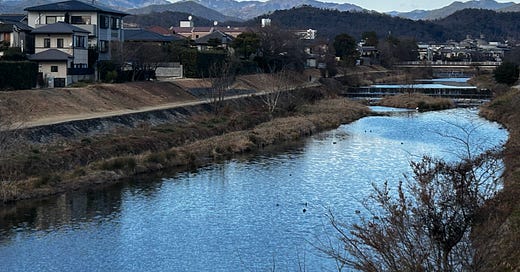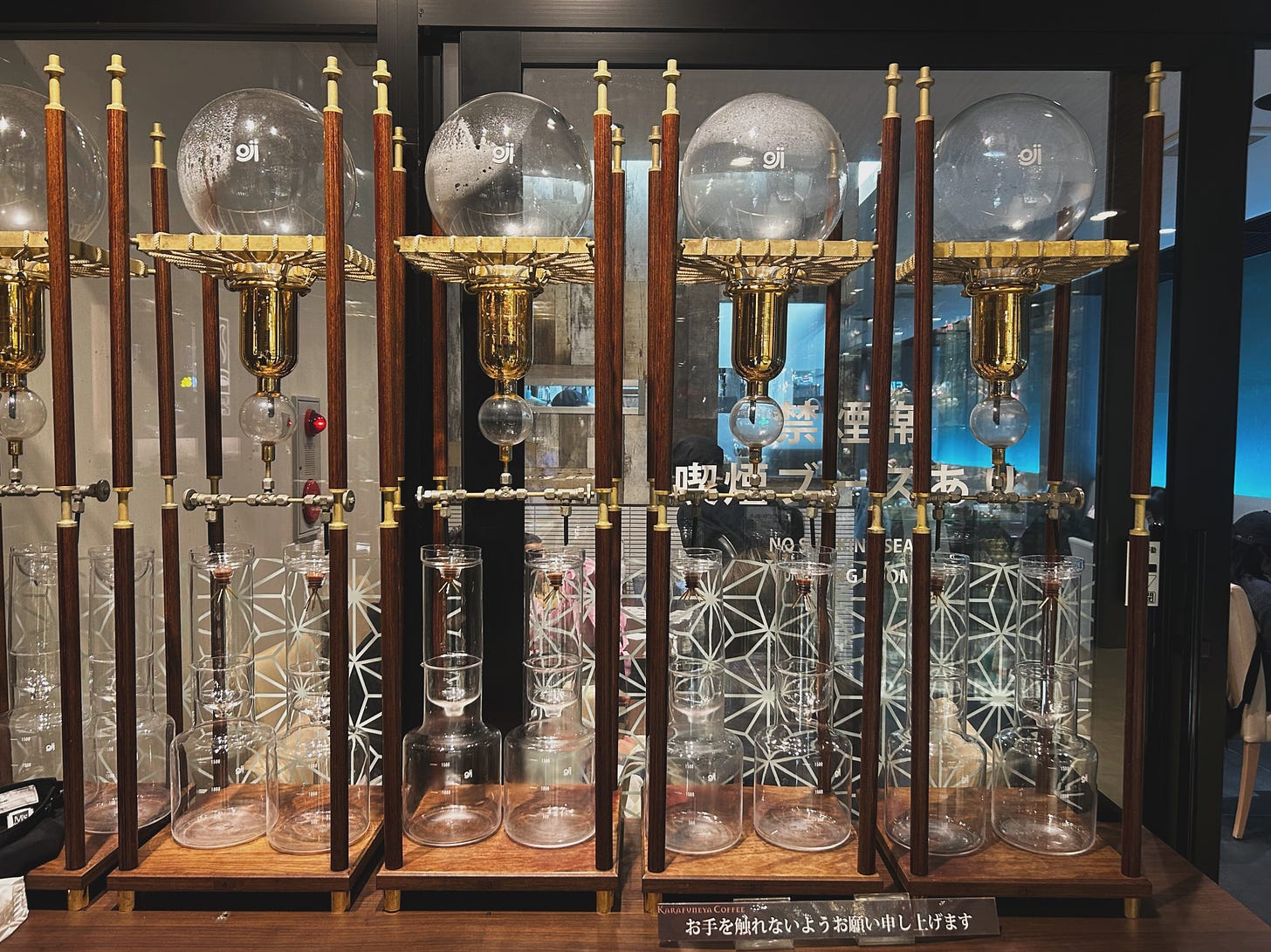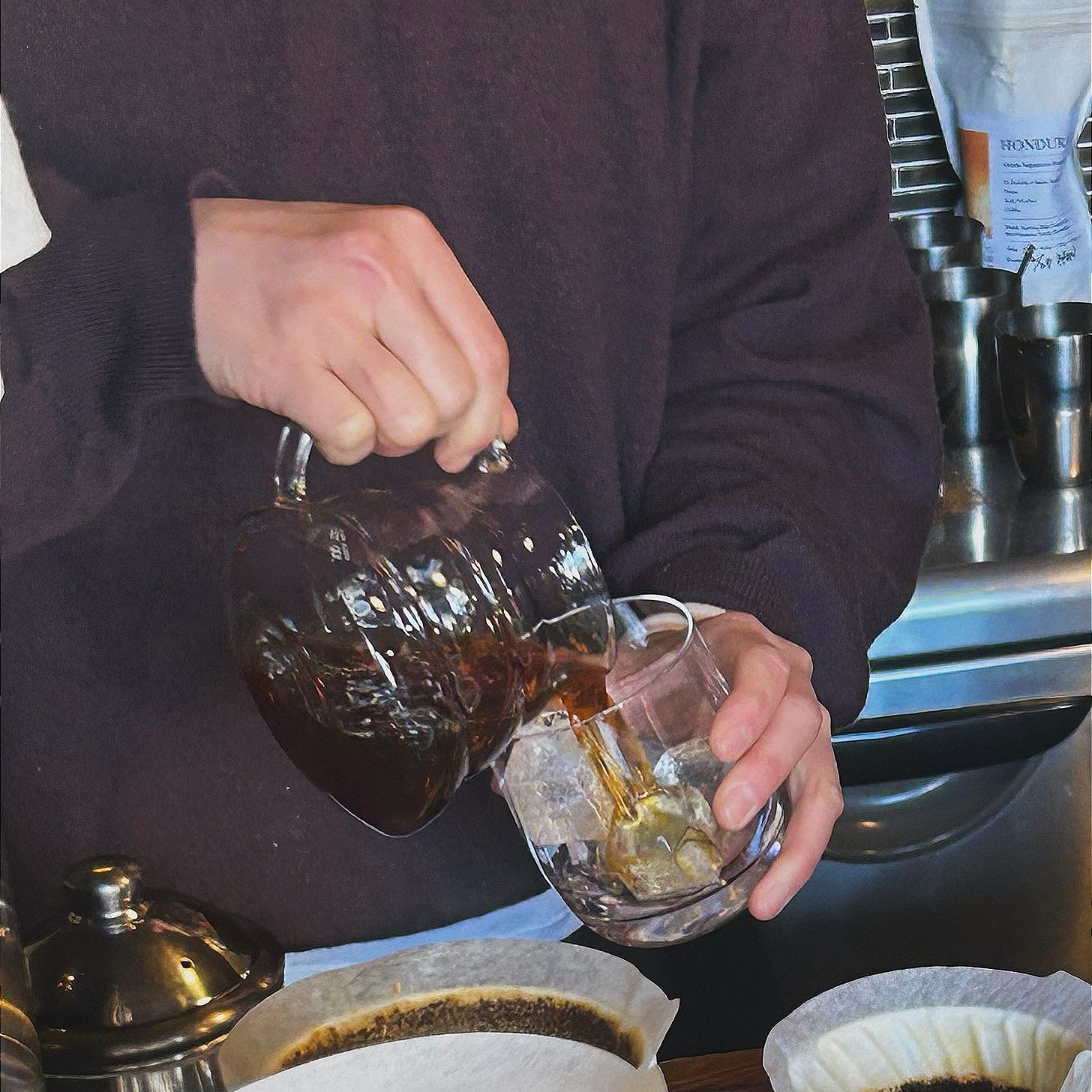Journal from Japan No.2 - Kyoto-style and the Origins of Cold Brew Coffee
From the cool waters of the Kamo in Kyoto to nitrogen chilled draft pours in Portland, Oregon, cold coffee has taken quite a journey. A controversial brewing method for some coffee purists, cold brew has experienced a meteoric rise in popularity in recent years. Its rise, however, is also controversial in the industry as it is often attributed to the large coffee corporations making it mainstream around 2015. These companies cannot be credited with its invention, however, as the method is several hundred years old and originates in Japan. In this journal I’ll first go over the origins of cold brew before diving into the Kyoto-style method. I will conclude with a brief look at Japanese iced coffee, a third distinct approach.
Mizudashi, the Japanese word for cold water brewing, is a process that was originally applied to brewing cold tea. It all began right here in my place of residence for these next few weeks, Kyoto, where cold river water from the Kamo was used to brew tea, as it avoided extracting unpleasant bitter notes from the tea leaves that result from brewing with hot water. When the Dutch arrived with coffee in the early 1700s, naturally the method was applied to the new product and cold brew coffee was born. The method today is most famously used to make dashi, a sauce which is a staple of Japanese cuisine. It’s important to note here, this idea of avoiding bitterness through cold extraction has to do with creating an umami flavor profile, one of the five basic tastes in cooking. In our case here, we are concerned with Washoku, the name for traditional Japanese culinary practice, specifically. A basic translation of umami is ‘savoriness’, and it wasn’t until Japanese scientists introduced the concept at a 1985 international symposium in Hawaii that the Western world considered it one of the five taste sensations alongside sweet, sour, salty, and bitter. Before this, it has been part of Japanese cuisine for millennia, and the original goal of cold brewing tea and coffee was to bring out savoriness in the drinks. Over time, various techniques for cold brewing developed domestically, but cold brew in Europe wasn’t popular and was only really a feature of Dutch coffee culture after their initial interactions with Japanese techniques. It is fascinating, as I note in my journal “Coffee of the Dutch Style”, that despite this, cold brew is no longer that popular in modern day Netherlands. However, by the end of the 1800s, following Japan’s de-isolation over the course of the century, cold brew coffee had swept throughout all of Europe. In the early 1900s, cold brew was becoming common in Central American coffee producing countries as well. Most famously a 1930s discovery in Cuba of a concentrate brewed from finely ground coffee was paving the way for a cold brew revolution. Coffee growers in this region started considering the possibility of their crop being brewed in this alternative manner when reevaluating their farming practices. Fast-forward to the 1960s, coffee companies in Japan began canning cold brew. This, followed by the introduction of coffee street vending machines in 1973, led to cold brew taking over the streets of Japan and the brewing method experienced another major boom. The Toddy Brewing System was invented in Colorado about a decade earlier. It’s a full immersion cold brew technique which became the default way to do cold brew in many coffee shops. Requiring just a bucket and a filter, it was simple enough that it also allowed people to make cold brew in their own homes. These factors couple together set the wheels in motion for cold brew becoming a hugely popular coffee drink worldwide. Then in 2010, the legendary Stumptown Coffee Roasters out of Portland, Oregon once again revolutionized cold brew when they borrowed from the craft beer industry and started pulling it through draft lines hooked up to nitrogen, creating the first nitro-cold brews. Seemingly as an ode to the origins of cold brew, Stumptown has their only non-US location in Kyoto. The café is coincidentally just around the corner from where I am staying, and it is extremely cool to see hundreds of years of history come full circle right in this neighborhood.
Before all that rapid development occurred in the back half of the 20th century and early 2000s, one specific cold brew technique spent decades, even centuries, getting perfected in the streets of Kyoto. As mentioned earlier, various cold brew techniques evolved in Japan. However, Kyoto-style cold brew, wasn’t actually invented by the Japanese despite being named after the old capitol. Kyoto-style is a slow drip cold brewing method invented by the Dutch. It got its name due to its preliminary widespread use occurring in Kyoto shortly after that initial exchange of coffee. It is absolutely the most time and labor-intensive cold brewing method, sometimes taking up to 24 hours to complete, with the time increasing exponentially with larger batch sizes. The brew process occurs in a contraption simply referred to as a Kyoto cold brew tower. Many craftspeople have produced various versions of these towers over the years, but today the most popular manufacturer is Taiwan-based glassmaker Yama Glass, who build their towers out of handcrafted wood, including a bamboo model, and borosilicate glass. A Kyoto cold brew tower is divided into three sections. At the top is a container for water/ice with a spout at the bottom. Below that, is the compartment for holding coffee grounds, followed by a carafe at the bottom which collects the cold brew. The traditional technique for utilizing a Kyoto cold brew tower is a tedious process that begins with ice, held in the hopper at its summit, which melts and drips down onto a bed of coarse-ground coffee. A notch on the hopper’s spout controls the speed at which water is allowed to drip down onto the bed. Upon sitting with the grounds for an extended period, accumulating one drop at a time, the brewed coffee flows down through a glass coil into the drip carafe at the bottom of the contraption. There are two paper filters present in the tower. One sits on a ceramic piece between the bottom of the coffee bed and the glass coil, and the other on top of the compartment holding the grounds, between the top ice hopper. It’s a highly artisanal approach to cold brew, quite different from the popular Toddy full immersion method discussed earlier. The end result is not only less bitter but also now less acidic, presenting a superbly smooth and balanced iteration of any coffee used. It is recommended that one sticks to medium-dark roasted blends for this method, although a well-developed single origin can produce a great outcome too. The faucet on the ice hopper, controlled with a screwed notch, dictates the speed at which the water will flow once melted. The more open the dripper is, the faster the brew time. But the best way to go about cold brewing in a Kyoto tower is to just barely open the faucet, allowing for a real slow drip as opposed to a quick flow. The reason you can adjust the faucet’s opening is for cleaning purposes, but you could in theory also brew hot coffee in one of these vessels. I won’t go much more into that here, as the tower is designed for cold brewing and is exclusively used for this. Brewing hot coffee in one of these will result in too slow of a brew time, and the coffee will be losing temperature before it is ever served. The only reason I can think of hot brewing in a Kyoto tower would be if you’re serving it later, over ice. With one of these, the idea is to keep the notch tightened and stick to a slow drop-by-drop drip brew. Grinding very coarse is crucial so that the drops can flow freely through the bed of coffee, rather than be allowed to over-extract in super fine grounds. The idea behind Kyoto-style vs other cold brew techniques is that it avoids a highly acidic profile that can arise out of cold brews utilizing finer grinds.
Cold brew is a worldwide phenomenon. But it isn’t the only way to enjoy coffee cold. This final part of the journal is an exploration of Japanese iced coffee, which is a pour-over brewed on ice. Despite cold brew's significance and origins in the nation, the most popular cold coffee technique in Japan today is iced pour-over. It’s exactly what it sounds like. A barista brews a hot pour-over, most commonly V60 or Origami, at the typical 195-205 degrees Fahrenheit, over medium-fine ground coffee, into a range server with ice sitting at the bottom. In Japan I’ve seen this done in a Kalita Wave dripper and a Chemex as well. It’s simple enough, but there is a slightly complicated element to it. Japanese iced coffee is a preferred alternative to cold brew coffee for many coffee enthusiasts who are put off by both the age of cold brew, which can sometimes be a week old or more, and the elevated levels of caffeine in cold brew, which can often lead to jitteriness in even the most caffeine tolerant coffee drinkers. It’s fresh, and the caffeine levels diminish due to the dilution from the ice. Here’s where it gets tricky though, because the main question asked of the barista is to account for the ice dilution when preparing the brew. This can be a point of panic, but don’t fret! The problem can be solved by adjusting the ratios. Since we are introducing water that won’t be getting brewed through grounds, we want to go with a brew that’s a little bit more concentrated. To keep things simple, it is recommended to have a coffee to water to ice ratio of 1:9:6. Meaning for a 500 gram brew, load 200 grams of ice into the range server, then brew 33 grams of coffee with 300 grams of hot water. For a Chemex I would extend that ratio to 1:12:8 and remember to grind slightly coarser than you would for a V60 or Kalita Wave. Once you're finished brewing, ensure that your ice has melted entirely. Check this by swirling the coffee until you can no longer see ice cubes. As with any brewing method, there are dozens of existing techniques, but the key thing to remember with Japanese iced coffee is that you want to brew a more concentrated coffee. A noteworthy iced coffee technique born out of Japanese iced coffee is hot extracted, flash chilled cold coffee. The technique is most famously applied by Dark Matter Coffee in Chicago who use this method exclusively for their iced coffees, just done at a larger scale for distribution. Imagine a pour-over, but instead of a V60 over ice, it’s a large bed brewed into massive, chilled basins. Flash chilling is a thermal shock to the coffee. Doing it in this manner preserves desired notes in coffee beans that have undergone atypical processes such as any experimental fermentation or barrel aging which give notes that could potentially dissipate if brewed directly over ice. Brewing Japanese iced coffee, as opposed to brewing hot coffee and letting it cool to room temperature before serving over ice, allows for the maximum extraction of soluble compounds (via hot water) without risking the potential staleness factor sometimes present in cold brew or room temperature iced coffee.
Cold brew coffee is an ideal brewing method for someone wishing to nullify undesirable characteristics arising from bitterness in the coffee. Hot water molecules zip around quickly, which is why they are able to break down all the compounds in coffee beans in a matter of minutes. Cold water molecules move around much less rapidly, so they never get around to breaking down all the compounds. In coffee extraction, bitterness comes from the plant fibers in coffee beans, which are the last thing to get extracted after first caffeine, fats, and acids, followed by sugars. But an intriguing thing happens with cold water extraction. The order gets shuffled up a little bit, and the cold water doesn’t extract acids in the beginning, nor does it extract all the same acids it does when hot. It still takes on acidic characteristics, which is why sometimes cold brews have a clear acidic profile, but certainly not to the extent hot water extraction does. This is why cold brews are higher caffeinated and tend to be more oily (from the fats). Kyoto-style is able to avoid acidity entirely because of the slow drip. By extending the brewing process, we give the water the necessary time to extract sugars, which give the coffee a sweetness that masks the acidity. Japanese iced coffee preserves the full flavor profile of the coffee, as it still goes through the regular extraction process (read all about this in the Coffee Ramble titled “Science Behind Coffee Extraction”) and is the ideal method if you’re looking to experience the true nature of the bean as a cold beverage. Both cold brew in general and this particular iced coffee technique herald from Japan, with some help from the Dutch; an exchange between two cultures which has produced the most innovative concepts and principles in coffee.
For those looking for an alternative to the potentially over-bearing sensory experience of hot coffee, cold brew coffee can be a perfect solution. Mellowing out bitterness and presenting a more savory profile, this method is a unique way to simplify a coffee’s flavor profile down to its most rudimentary notes. Plus, it is refreshing on a hot summer day, as well as an efficient option for coffee when you’re in a rush. But, if you enjoy the dynamic elements of a particular coffee and still want to enjoy it cold, iced pour-over is a wonderful option as well. Both have their roots in Japan, which is no surprise given the nation’s emphasis on efficiency and practicality. Tie into this the artisanal nature of the culture plus the pursuit of finding a balance between modernity and tradition, and we see how such simple concepts on paper can be developed and redeveloped over the course of a few centuries and are likely to continue evolving over the next decades. For now, though, I’ll be getting back to enjoying the sweet flavors of a Kyoto-style cold brew from a local coffee shop.








